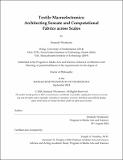Textile Macroelectronics: Architecting Sensate and Computational Fabrics across Scales
Author(s)
Wicaksono, Irmandy
DownloadThesis PDF (30.72Mb)
Advisor
Paradiso, Joseph A.
Terms of use
Metadata
Show full item recordAbstract
Textiles are omnipresent and among the oldest forms of art and culture in human civilization. They serve as our protective skin, the interface between our bodies and the environment, and a medium for self-expression and collective experience. As electronics become more compliant, miniaturized, and low-cost, textiles provide an ideal substrate for technology integration, further driving the era of ubiquitous computing. My research fuses recent advances in functional materials, digital fabrication, hardware systems, and immersive technologies to demonstrate Textile Macroelectronics architecture and develop sensate and computational fabrics across scales.
In this dissertation, I propose a ubiquitous computational textile framework—a synergy between functional device selection, textile structures, fabrication tools, and system architecture—that integrates a distributed network of sensing and computational elements as primitives or raw materials in the manufacturing process of electronic textile products. In the first part of the dissertation, I present several methods, artifacts, and implementations of sensate textiles using functional fibers and digital machine knitting. I argue that to promote the disruption and adoption of sensate textiles and achieve seamless integration, we require a better hierarchical understanding of textile construction and fiber-fabric properties, as well as ways to integrate electronics and functionalities with industrial textile fabrication processes. By controlling functional and common yarn inputs, along with knitting structures and patterns, I can architect fabric forms and aesthetics while tuning their electrical and mechanical properties. With this approach, I have developed a set of custom proxemic and tactile textile interfaces based on capacitive and piezoresistive sensing for musical expression, human-computer interaction, activity recognition, and multi-sensory experiences in various forms such as cloth, footwear, mats, carpets, and large-scale architectural facades.
In the second part of the dissertation, I will discuss my work in exploring flexible, stretchable, and soft printed circuit technologies, incorporating multi-modal sensing with distributed computation to address scalability issues inherent in large and dense sensate textiles. These efforts have led to unique power, interconnection, and networking paradigms that allow us to transition from application-specific sensate textiles to generic computational fabrics that can be tailored and programmed for various applications. Finally, through these collective and complementary efforts, I aim to demonstrate an ecosystem of fabric artifacts that will lead us toward an Electronic Textile Gaia—a vision where sensing and intelligence are seamlessly interconnected and integrated into the fabric of everyday life, from in-body, on-body, room-scale, to architectural textiles, for applications ranging from physiological and physical activity monitoring to interactive media and built environments.
Date issued
2024-09Department
Program in Media Arts and Sciences (Massachusetts Institute of Technology)Publisher
Massachusetts Institute of Technology